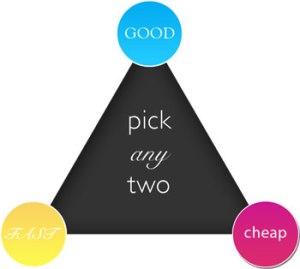
Triangle of compromises, from 11 Bridges.
You’re likely familiar with triangular development tradeoffs: good, fast or cheap—pick two.
However, I suggest that when people are empowered to control their own learning, at their own chosen times, and within a framework that supports personal exploration and mastery, it is the epitome of learning efficiency. That is, better, faster and cheaper!
What does that look like?
Let’s take a look at a common professional services business topic: managing client expectations. It could have been any number of hard or (especially) soft workplace skills, but for our purpose here, let’s go with managing clients.
Traditional training and L & D approaches call for a comprehensive set of learning and mentoring activities. These may include classroom time with role-plays, eLearning courses sequentially laid out in an LMS, conference attendance, webinar sessions, readings, etc. There is nothing wrong with these approaches, but they don’t sit comfortably on two points of the tradeoff triangle, and certainly not all three. If done well, and tracked to metrics to demonstrate efficacy, the traditional treatment is a large, expensive endeavor. It may be worth it in the long run, but it is hard to get support for such rich projects.
Imagine an alternative program, one in which individuals are able to control their own professional development with thoughtful guidance. The added element is that the learners have to demonstrate their work—that is, work out loud as they collect information, connect ideas and form practices that fit into the working culture.
Perhaps you begin by providing a curated, annotated list of articles, videos and websites. Ask the learner to review and reflect on those items. Then, assemble additional resources into a collection (social bookmarked via Diigo, Scoop.it, Delicious, etc.) The collections are open to others, so that they share as they save (share is the new save!) via the enterprise social network (if one exists) or Twitter, Facebook or any other available platform. Every week or so, learners come together to present, discuss, compare and practice together for a short time (say, a working lunch hour, in-person or via web-based meeting platform), under the direction of a mentor and/or learning professional.
What have you gained? A cohort that is mostly self-directed, taking responsibility for their own development, creating a learning and collaborative culture, and normalizing how to manage client expectations (see how the topic almost becomes secondary—in a good way!) together with the manager’s direction.
If you have one or two great ideas for good interactive modules or focused, purposeful webinar topics, great. This framework allows targeted, well-designed instruction to take root in the larger learning culture.
What you end up with is an effective learning program, potentially bringing higher and more diverse quality than is possible from even the best L & D team on its own, while saving the cost of numerous eLearning courses or formal learning events. It drops the assumption that the established practices for client management already in place are better or preordained, welcoming ideas from across the networked world.
It covers all three corners, enabling a full 180° horizon, overcoming false choices that stand in the way of organizational agility and vision.

Open the triangle and see the horizon of learning (and perhaps, the reading rainbow).
Tags: constructivism, CoP, curate, design, Insrtuctional Design, learning




